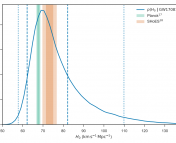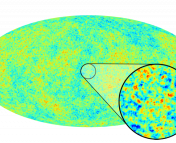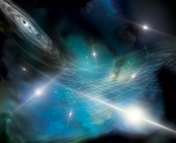Title: High-Frequency Gravitational Wave Detection via Optical Frequency Modulation
Authors: Torsten Bringmann, Valerie Domcke, Elina Fuchs, and Joachim Kopp
Author Institutions: University of Oslo; CERN; Leibniz Universität Hannover; Physikalisch-Technische Bundesanstalt; PRISMA+ Cluster of Excellence & Mainz Institute for Theoretical Physics
Status: Submitted to arXiv
Currently operating and planned gravitational wave (GW) detectors target frequencies ranging from nanohertz to about 10 kilohertz (kHz). Exploring this range is well-motivated: signatures from known astrophysical sources (such as compact objects like black holes and neutron stars) are expected and there are also many possible cosmological sources (backgrounds from phase transitions in the early universe, inflation, and more) which would fall within it. Any signal with a frequency greater than 10 kHz is referred to as ‘high-frequency’ since it is higher than what current experiments can detect (see Figure 1). At these larger frequencies, there are no known astrophysical objects which would produce detectable signals. Thus, an observation of high frequency GWs would indicate astrophysical phenomena involving physics beyond the standard model (e.g. exotic objects such as primordial black holes or boson stars) or cosmological events in the very early universe (e.g. phase transitions, preheating after inflation, cosmic strings, thermal fluctuations after reheating). Exploring this range of novel physics also requires novel approaches. The authors of today’s paper propose a method for detecting high-frequency GWs and suggest some experimental methods from quantum optics to search for signals.
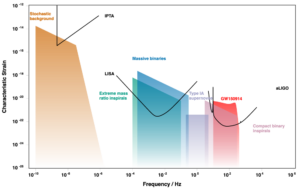
How Not to Build a High-Frequency GW Detector
As a starting point for exploring the high-frequency range, one might envision modifying current models of GW detectors for sensitivity over a different frequency band. For example, shortening the arm lengths of a laser interferometer would make it more sensitive to larger GW frequencies. However, this would also lead to much smaller sensitivity and even make the signal undetectable. Another possible method is using atomic systems, translating their precision in frequency measurements to the tiny effects induced by GWs as they stretch and compress space. However, there are some major obstacles when it comes to resolving the GW signal. Fortunately, today’s authors have ideas for alternative methods which circumvent these problems.
GW Detection Methods
The authors propose three different experimental methods that use observations of photons to detect high frequency GWs. The path of a photon is affected by passing GWs, which stretch and compress space as they travel. The photon’s frequency is altered in the process and leads to potentially observable affects which encode information about the passing GW.
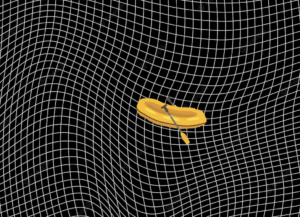
I. Sidebands
The light from an intense monochromatic (single color, or frequency) laser has a known source frequency. A passing GW will modulate this frequency, producing sidebands– frequencies higher and lower than the source frequency– in the spectrum of light observed at the detector. These sidebands will occur on either side of the source frequency with a displacement equal to the GW frequency. Thus, directly observing these sidebands in the photon signal provides information about the frequency of the GWs modifying the signal. These sidebands are expected to be faint, so their detection requires a very powerful photon source and a very efficient optical filter system. The authors suggest that optical cavities and techniques from fiber optics may be viable methods for table-top (yes, that small!) GW detectors. Sensitivity estimates are indicated by the orange lines in Figure 3.
II. Optical Demodulation
The way in which a GW modulates the frequency of a propagating photon can be compared to how a frequency modulator (FM) radio transmitter modulates the frequency of an FM carrier. Fortunately, FM radios are already well-understood and advanced de-modulation techniques exist! The authors suggest that these techniques can help to de-modulate photon signals to learn about passing GWs. They propose splitting an incoming photon beam and filtering the two beams such that they interfere destructively, leading to no signal. However, a slight frequency shift due to modulation by a GW would disrupt the destructive interference, leading to a nonzero signal in the detector. The sensitivity estimates are shown by the cyan lines in Figure 3. Note that for sensitivity to higher frequencies there is a tradeoff with sensitivity to small GW amplitudes.
III. Atomic Clock with Optical Rectifier
Optical atomic clocks allow the detection of tiny frequency shifts in optical signals and have been proposed as a detection method for photon modulation by GWs. However, achieving the desired frequency resolution requires long measurements (beyond several seconds) over which the effect of a high-frequency GW would average out. The authors propose an ‘optical rectifier ’ to prevent averaging out the signal. In the simplest case, a shutter is used to block the optical signal during half of each GW period. This makes the frequency shift of the photons nonzero, and detectable via atomic clock techniques. The downside is that it requires prior knowledge of the frequency and phase of the GW in order to properly set the clock to detect the signal. However, if the GW signal has a broad frequency spectrum, then detector sensitivity over only a very narrow frequency interval is sufficient. Sensitivity estimates for this technique are given by the blue lines in Figure 3.
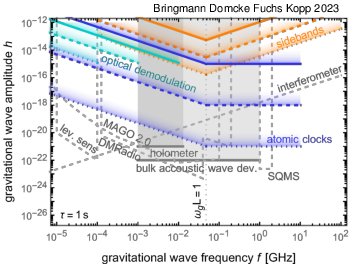
The three novel methods for detecting ultra-high frequency GWs proposed by today’s authors have promising sensitivities across the MHz and GHz frequency range. This work adds to the list of experiments attempting to push the current boundaries of GW exploration and aims to inspire more ideas and in-depth studies for future detectors.
Astrobite edited by Cole Meldorf
Featured image uses images from the main paper (waveforms), The Ye group and Brad Baxley, JILA (clock), (radio), (interferometer), and public domain.

